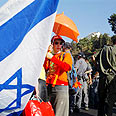
We must keep marching on
The Kfar Maimon protest was only the beginning -- pullout opponents won't give up, Shaul Goldstein says
After a nightly meeting with high level police officers and a tense, hot and humid day, I asked a police commissioner what he thought there were more of in Kfar Maimon—anti-disengagement protesters or security people.
“There are a lot of citizens of Israel here," he said.
For some of those who entered Kfar Maimon’s gates, there was a strong desire to win. The town could have easily turned in to a symbol as the place that sparked a civil war. God forbid.
There were those who came with a feeling of true self-sacrifice and planned to carry out the march “to the end”: Those people left very disappointed, even with a sense of betrayal and deception. They expected that we will rise upon the ramparts and “go through” the soldiers and policemen.
The truth is that when we stood there with the rabbis and Knesset members at the head of the procession, I felt that if we just tell the people to head to the gates and go, those 35,000 demonstrators would knock down that fence as if it were made of straw, and no power in the world could stop them.
The enormous energy we felt there tempted us to use it – yalla, let’s show that prime minister! But that wasn’t our goal.
We didn’t come to triumph over the IDF or the police. We didn’t come to prove that we are ready and able to get beaten up or hurt by anti-riot gravel or water hoses. We knew we could do that already.
Battle of public opinion
No, we went that long route because we wanted to win the battle of public opinion. The battle for national awareness. And it is here that our greatest successes were realized, that hopefully will remain.
For most of the hours of the day and night of the march, Kfar Maimon resembled a colorful vacation campground. The heat and humidity, lack of showers or normal bathrooms should have sapped us of our energy, but the knowledge that we were marching to our brethren that need us so much now, helped recharge our batteries.
The orange-bedecked students shook things up with organized marches, holding aloft posters that said things like: “Zionism and not just Zionists”, or “I’ve got a thing for Gush Katif” and the like. Most of the youth were busy doing the things that youths do.
But other youths, along with the adults, showed us just why these youths are the greatest in the world: they went out to meet the soldiers and the policemen, directly and without intermediaries. They brought with them water, candies, ice pops and a great deal of love.
I stood on the side and listened to some of the discussions. Many politically charged subjects came up, like what the meaning of a home is, what is the meaning of the word ‘motivation’, and what is freedom of expression. I didn’t hear arguments, I heard discussions.
At night, when the tail end of the procession had disappeared, and only three thousand or so were left at the back gate facing thousands of soldiers, I saw the two extremes: groups of youths, both uniformed and not, on both sides of a barbed wire fence, and then another group of youths, ready to take out their barbed wire clippers from where they were hidden in their sacks.
Fire in the eyes
I approached the latter: They were young, with winning smiles and fire in their eyes and no desire or patience to listen. For 20 minutes we went through all the possible scenarios. We received virtual beatings, we ran those 11 kilometers at great speed, and we brought 30,000 virtual people to the Kissufim Crossing.
Symbolically, we also waited for someone to come and release us (because a month in that heat can really dehydrate). And after we understood that we still haven’t won, we began a very non-virtual discussion about how we could win. We also understood that neither the IDF nor the police are the objectives to triumph over. Somehow those wire clippers became superfluous all of a sudden.
In a period of such turbulence, leaders are the first to be tested. The Prime Minister and his ministers are trying to sow divisiveness. Their unrestrained attacks and attemps to paint their objectors in a black light (“rebels”, “outlaws”, “poisoners of our youth” and so on) have enabled them, for the first time in our history, to use the army against its people within the boundaries of Israel.
The “democratic” left fell silent, and there at the edge of this division and hypocrisy, is where they will remain. Actually those who were able to acknowledge and criticize this process of disunity, and who initiated contacts between brothers—they will be kindly judged by the light of history.
The leaders of the current struggle, the Council of Judea and Samaria, the rabbis and the MK’s chose the long term benefits of the unity of the Israeli nation—with determination and self-sacrifice on behalf of Gush Katif—and not a local victory of a physical breakthrough at Kfar Maimon; a victory with a short shelf life.
Instead, Kfar Maimon became a symbol of self-sacrifice and determination but also of preservation of the bonds of brotherhood that unite our society. We aren’t giving up, not on the struggle and not on our brethren. “We must keep marching on, we must keep marching on…”
- Shaul Goldstein is the head of the Gush Etzion settler's council in the West Bank










